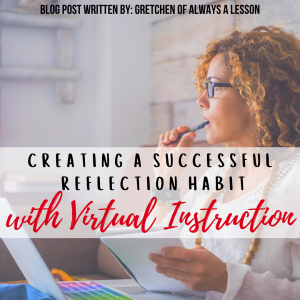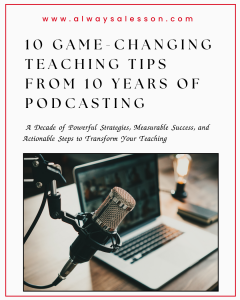Creating a Successful Reflection Habit with Virtual Instruction
Developing a successful reflection habit is essential to success in the classroom. Virtual instruction became the norm overnight with little instruction or support. With almost an entire calendar year implementing some type of virtual instruction under educators’ belt, reflecting now can be powerful for a fresh, successful year ahead.
The tips outlined in this blog post will help develop the habit of reflection, but specifically hone in on the virtual instruction element.
Daily Reflection Habit
 Routines create a sense of safety and predictability. Days that are rooted in repeated practices often increase satisfaction, as if checking off the boxes on a long to-do list. A reflection habit is no different. Spend a few minutes each day thinking back on virtual instruction- what went well and what didn’t. Problem solve for the next day. A daily reflection habit allows for tweaks in approach at a faster rate. That intentional responsiveness is a characteristic of any elite educator.
Routines create a sense of safety and predictability. Days that are rooted in repeated practices often increase satisfaction, as if checking off the boxes on a long to-do list. A reflection habit is no different. Spend a few minutes each day thinking back on virtual instruction- what went well and what didn’t. Problem solve for the next day. A daily reflection habit allows for tweaks in approach at a faster rate. That intentional responsiveness is a characteristic of any elite educator.
Weekly Reflection Habit
Similarly to a daily reflection habit, looking back on your virtual instruction with a weekly glance allows for more clarity in decision making. Sometimes a single lesson flops, but in the greater scheme of things, the virtual instruction strategies are moving in the right direction. Zooming out during a weekly reflection allows for perspective, which then creates sound decision making. Think about problem solving big hiccups and celebrating forward momentum.
Monthly Reflection Habit
Virtual instruction continues to change as different platforms emerge for schools to explore. Looking back at the previous month before planning the next month ahead allows for greater understanding in the flow of instruction. Did you meet or exceed academic goals this month? Why or why not? Did you hit your learning targets this month? Why or why not? Thinking big picture backwards and forwards keeps you aligned and on track.
Quarterly Reflection Habit
Great educators plan backwards to ensure each day of instruction adds up to the greater goal and vision for the quarter and year. Evaluate the success of instruction as mini milestones leading to grade level proficiency. What projects, assessments and activities clearly and fairly demonstrated student understanding? Which ones lead to confusion, frustration and poor performance? Pay special attention to high engagement opportunities and positive feedback from students.
Yearly Reflection Habit
As a school year or calendar ends, it presents a hard break – a perfect place to pause and reflect. Review all high’s and low’s of that year, making note of what to replicate and what to change out. Uncover reasons for success and struggle. Create an intentional plan to build off the hard work of the year.
Reflection Habit Tools
Below are tools I use in the classroom to build a successful reflection habit. Grab what you need:
-
- Teacher Video Reflection– Watch yourself teach! Then use these guiding questions to reflect on the effectiveness of your instruction.
- Teacher Observation Reflection– After you get observed, reflect on your performance before meeting with your observer. This allows you to process how things went and bring your thoughts to the discussion. These guiding questions will transform your instruction.
- New Teacher Reflection Journal– Track all of your aha moments- good, bad and ugly!
- Student Work Reflection– Before students turn in their work, require them to self-assess. This extra glance helps students catch errors and increase the quality of their work. Great for all subjects!
- Student Behavior Reflection– After a misbehavior occurs, ask students to reflect on their choices prior to speak with you the teacher. This allows them to gather their thoughts and words before discussing the incident. It also serves as a good paper trail of behavior intervention.
- Student-lead Book Club Reflection Sheet– Create groups of readers that come together to discuss a common text without you the teacher. The reflection sheet serves as a assessment to keep students accountable for their actions and interactions.
- End-of-Year Parent & Student Reflection– The best way to hone your craft is to ask your best customer- students and their parents! Their perspective is important to understanding learners in the environment you cultivate. They truly are the best partners in improvement.
No matter the frequency, I hope you begin to develop a reflection practice that is productive in making you a more effective educator, virtual instruction and beyond!
Do you want to go through the reflection process with a thought partner? Hop on a coaching call with me to peel back the layers of your year and plan for better instruction ahead!
Go Be Great!
How do you plan to incorporate a reflective practice with virtual instruction?


